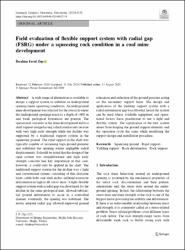Field evaluation of flexible support system with radial gap (FSRG) under a squeezing rock condition in a coal mine development
Abstract
A wide range of alternatives is available to design a support system to stabilize an underground opening under squeezing conditions. An underground mine development was selected for the research where the underground openings reach to a depth of 1000 m and weak geological formations are present. The operational concerns in the mine development led to a shaft support design having a thick reinforced concrete with very high early strength while the decline was supported by a traditional support system in the squeezing ground. The rigid support in the shaft was typically capable of sustaining high ground pressure and stabilized the opening within negligible radial displacements. It should be noted that the design of the rigid system was straightforward and high early strength concrete had key importance in this case, however, it could only be applied in the shaft. The traditional support system for the decline was a light and conventional system, consisting of thin shotcrete layer, cable bolts and steel arches suffered excessive deformation as high as 60 cm or more. A light-flexible support system with a radial gap was developed for the decline in the same geological unit, allowed substantial ground deformation to occur in a controlled manner, eventually, the opening was stabilized. The newly adopted radial gap allowed improved ground relaxation and reduction of the ground pressure acting on the secondary support layer. The design and application of the yielding support system with a radial deformation gap was effortful, hence the system can be used where available equipment and operational factors force practitioner to use a light and flexible system. The significance of the new system arises from keeping the ground support elements and the operation cycle the same while modifying the support design and installation procedure.


















